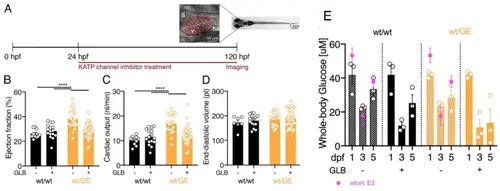
Glibenclamide corrects CS-related cardiac phenotype in Sur2wt/GE larvae. (A) Sur2wt/GE larvae were exposed to various KATP inhibitors over a period of 96 h starting at 1dpf. Larvae treated with DMSO were used as a vehicle control. (B-D) CS-associated cardiac features, namely ejection fraction, cardiac output and end-diastolic volume were assessed in Sur2wt/GE larvae after GLB treatment using high-speed video imaging. For all graphs, significance was determined by one-way ANOVA and subsequent post-hoc Tukey’s test for pairwise comparison: * p<0.05; ** p<0.01; *** p<0.001; **** p<0.0001. Data shown as mean ± SEM. Sample size: (B-D) wt/wt(-), n = 10; wt/wt(+), n = 16; wt/GE(-), n = 19; wt/GE(+), n = 41; All embryos analyzed originated from group matings of adult Sur2wt/GE zebrafish. (E) Chronic exposure to glibenclamide reduces whole-body glucose levels in CS zebrafish larvae. Absolute glucose levels in larval lysates consisting of a pool of 10 larvae each were measured applying a highly sensitive glucose assay kit. Glucose was measured in WT fish and fish prior to glibenclamide exposure at 1 dpf and after at 3 and 5 dpf. Mean whole-body glucose measurements from WT and Sur2wt/GE control and GLB treatment group. Additionally, absolute glucose levels of WT fish grown in E3 medium are shown.
|

